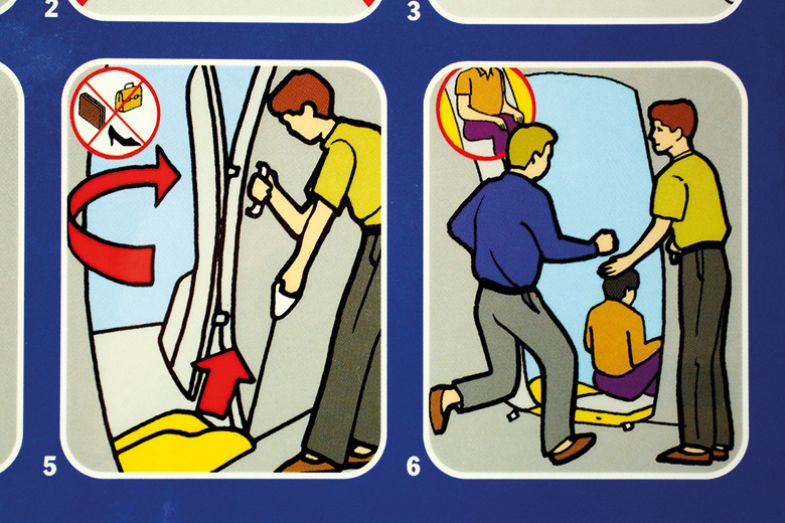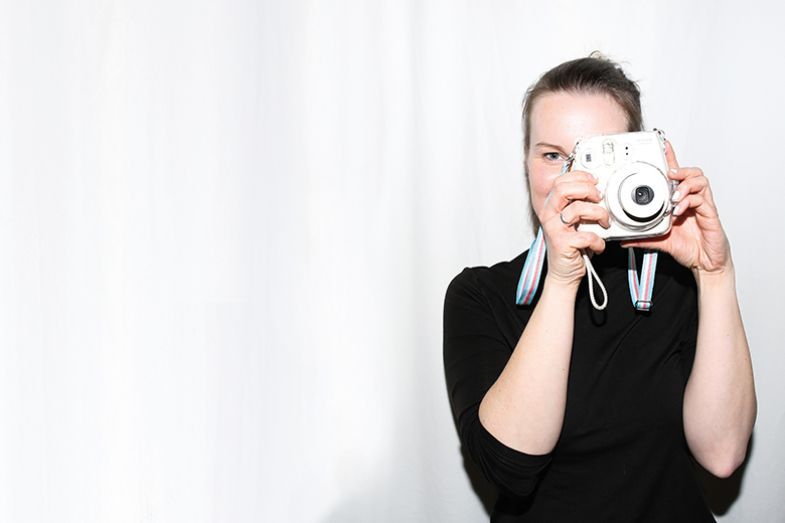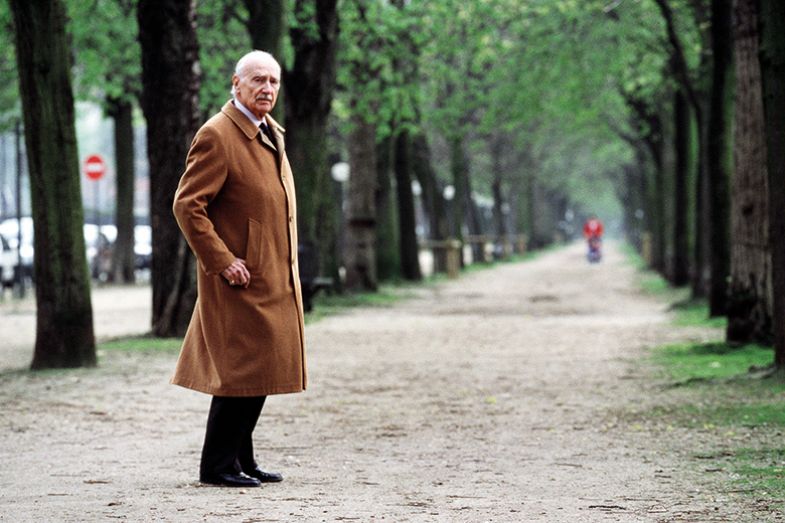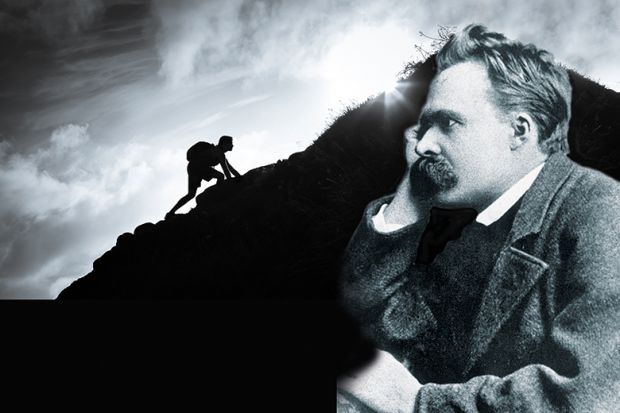‘That night, I encountered Nietzsche’s “abyss”: the one that you gaze into long enough and suddenly it gazes back’
I was 19 when I took my first course on existentialism, focusing on the writings of Friedrich Nietzsche.
I both adored and abhorred him, and over the course of the semester, I decided to title my master’s thesis Nietzsche – on genius, insanity, and the ascetic ideal.
Yes, I know – I should have known better. Now, I should tell you that I come from a small, cloistered, conservative town in the middle of Pennsylvania. My professor, Doug Anderson, knew this.
He was modest, very smart, responsible – just the sort of mentor that I thought, quite rightly, I should trust. At the time, Dr A, as everyone called him, struck me as very “square”: clean shaven, closely cropped hair, buttoned-down Oxfords. At the end of the semester, however, he handed me an envelope with a cheque for $3,000. He had gotten some discretionary grant from the university, and he suggested that I should use it to “go to Basel this summer”.
“Go hiking with Nietzsche,” he said. “Don’t be afraid to let go a little.” So I did. I spent exactly one night in Basel – the locus of Nietzsche’s traditional professorship in philology – and then I ran off. Got lost, really.
Since I was writing about asceticism – the self-control and self-deprivation that Nietzsche so often criticised – I thought I would try it. So I stopped eating and started walking. Since Nietzsche loved walking and mountains, I tried to walk across the mountains. Straight across, directly from Splügen to Sils Maria, on the Italian border.
It is 25 miles, I thought: I can do it in a couple of days. I had never been ice climbing or even camped in the backcountry but, after 15 hours of hiking, I made it to about 8,000 feet – still well below the 11,000-foot peak of Piz Plata – and pitched my tent. But, that night, I encountered Nietzsche’s “abyss”: the one that you gaze into long enough and suddenly it gazes back. I also got windburn – or perhaps it was frostbite – and it took me two full days to get back to Splügen.
I spent the next nine weeks fasting and hiking through the Alps, primarily around Sils Maria. I stayed on the second floor of the Nietzsche Haus (now a museum), the house where Nietzsche summered and wrote his famous novel, Thus Spoke Zarathustra.
I was 25 pounds lighter when I returned home. I never found Nietzsche, but I did come into contact with insanity and a full-fledged eating disorder. The trip changed permanently the way I experience hunger and my body, but also the way that I experience philosophy. For better and for worse, I was a philosopher after that encounter with the existential vacuum and human fragility 8,000 feet up a mountain, which colours my thinking to this day. Philosophy can change your life. But not always, or even usually, exactly in the way you expect.
This sounds harsher and more depressing than it actually is: I am so very thankful for the chance to hike with Nietzsche and to “let go” for just a little while – it proved, among other things, that life does not go to pieces when you do that.
Doug Anderson is still the sort of mentor that students should trust. His hair is now long, and his face is no longer clean shaven. He has, in his words, returned to his “natural state”: the state he was in before he became a respectable professor. He has also “let go” a bit and, like me, seems happier for it.
Now that he is one of my closest friends, I asked him one evening why he decided to support my first trip with Nietzsche. “It just seemed like something you would want to do: something that you would have wanted to have done,” he said. “Now you get to do that for your students.”
He is, I hope, very right about this, too. I now tend to wear Oxfords, keep my hair relatively short and my face shaven. It is good idea, sometimes, to at least look square.
John Kaag is a professor of philosophy at the University of Massachusetts-Lowell. His latest book Hiking with Nietzsche: Becoming Who You Are, will be published by Farrar, Straus and Giroux in the US this autumn and with Granta in the UK.
 Source: Alamy/Getty
Source: Alamy/Getty

‘She brought me a cup of tea and a newspaper in bed. I felt overwhelmed by her kindness and ready to face the world’
In 2009, I was an ageing postdoc with a trail of short-term contracts and fellowship rejections behind me – not to mention my failed relationship. My future was very unclear and I had eight different CVs describing me in myriad ways with a view to landing a permanent job in something – anything! – related to science.
Someone suggested that I attend the Springboard Women’s Development programme, and I figured I had nothing to lose. The organisation’s courses were criticised in Times Higher Education earlier this year for teaching women that their image is more important than the quality of their work (“Female academics told image more important than quality of work”, News, 24 January). I don’t know about that; I’m sure I’d remember the outrage if I’d been advised to buy a designer handbag. The effect the course facilitators had on me was of a very different kind.
Liz Elvidge, tireless promoter of the eternally neglected postdoc population, will get her own article from me one day, but here I want to talk about Gillian Neish. Despite my having been too mired in misery to embrace the “girl power” tone of the course, Gillian casually invited me to stay with her in Glasgow if my troubles ever threatened to overwhelm me.
Unbeknown to her, “never decline an invitation” had been my new year’s resolution, so I took her up on her offer a few weeks later. We had a lovely weekend; one day hiking on the West Highland Way and the other in town seeing art. On the final morning, Gillian had to leave for work well before I needed to go to the station, so she brought me a cup of tea and a newspaper in bed. I felt overwhelmed by her kindness and ready to face the world.
In the days that followed, I won a Medical Research Council New Investigator Research Grant, which kick-started my independent research career, and I met the man who is now my husband and the father of my children.
Earlier this year, I interviewed Gillian, en route to examining a PhD in Dundee. She was born to a Sierra Leonean woman who abandoned her in daycare at only six weeks old. She grew up in the care system, mostly fostered by a white family. She passed the eleven-plus but hated grammar school and played truant. She failed botany A level but her teacher, whose husband worked at Marks and Spencer, suggested she apply there.
She started in the lingerie department and shone as the “bra queen”. But it was in the food hall that she became aware of class differences: “I didn’t know what mayonnaise was – I didn’t know you could have gin with tonic or steak that wasn’t well done.” Moreover, the more senior she got, the less diversity she saw: “I knew there were people with potential who didn’t understand the system or have the confidence to rise through the ranks and I wanted to help change that.”
Having made many a social faux pas during my PhD at the University of Cambridge and having informally coached several state school kids into Oxbridge, I identify with these observations.
Gillian has since gained an MSc in diversity management and still enjoys an active career in training, particularly on matters of race. Her raison d’être is to “provide a safe space in which people can be honest and authentic, recharge their batteries, take stock of their bruised bits, replace their armour and get back out there”. I will always be grateful that she did that for me.
Rivka Isaacson is a senior lecturer in chemical biology at King’s College.

‘I had to endure being told just what we physicists were getting wrong by someone who lacked even the most tenuous of grips on the fundamentals’
You’re Phil Moriarty, right? Off that Sixty Symbols channel?”
I was queuing to board a flight at East Midlands airport a few years ago, on my way to a project meeting for a European network I was part of. Although I can’t remember the precise date, I can clearly recall that it was early in the day; having had no more than two coffees, I was still nowhere near as caffeinated as I would have liked.
I smiled and nodded at the guy who’d tapped me on the shoulder. Yes, I was indeed Philip Moriarty, and, yes, I’d made a number of videos for Brady Haran’s Sixty Symbols YouTube channel. Along with a number of my colleagues at Nottingham, I’d been working with Brady for a number of years, making short, quirky (ie, corporate gloss-free) films related to a variety of topics in physics and maths, and occasionally veering off to discuss more general aspects of science, education and academia.
Brady’s channels have accrued a substantial subscriber base and many of his videos pick up hundreds of thousands of views. Some pick up millions. So, occasionally, those of us who appear in them are recognised when we’re out of our natural university habitat. This attention can range from the flattering and humbling to the somewhat unsettling. With regard to the more troublesome end of this spectrum, the lyricist in a Canadian hard rock trio known as Rush – whose music I am rather partial to – perhaps put it best: “I can’t pretend a stranger is a long-awaited friend”.
My interlocutor in this case was clearly a big physics fan and I chatted with him about writers and science popularisers I admired – Brian Greene, Sean Carroll, Lisa Randall, Brian Cox – while trying to maintain a modicum of focus on making it to the end of the queue without losing my passport and/or boarding pass (it’s happened before).
And then came the bombshell.
“I’ve been working on this theory showing how quantum physics is actually all wrong. Physicists have been missing what’s right beneath their noses. Can I tell you about it?”
It was too late now to run screaming from the departure lounge. There was no way out except on to the plane. But, I reasoned, at least there must be fairly good odds of not being assigned a seat next to this guy.
I was right. And wrong. A frustrating superposition of states. The flight was nowhere near fully booked and there was a spare seat next to me.
So for the best part of two hours, I had to endure being told just what we physicists were getting wrong by someone who lacked even the most tenuous of grips on the fundamentals of quantum physics: someone for whom wave function and probability density were nodding acquaintances via a smattering of YouTube videos and popular science books.
No amount of patient, tactful (and increasingly less tactful) explanation as to where and why his “theory” made no sense at all had the slightest impact. I had encountered the living, breathing counterpart of the “green ink” letter writer of days of yore – or, more recently, the type of person who gleefully spams thousands of physicists with emails titled something like “The Uncertainty Principal is UNTENABLE!!!” (sic).
This brief encounter was nowhere near brief enough for my liking. Nonetheless, I learned a great deal in those couple of hours about the pitfalls and pratfalls of science communication – and, more broadly, about attempting to connect with a non-receptive audience. Universities now encourage researchers at all career stages to get “out there” and disseminate their work as widely as possible, as if the public were waiting with bated breath to be told of the latest research wonders to emerge from the hallowed halls of academia. But we need to realise that, as Tom Nichols describes so well in his 2017 book The Death of Expertise, academic knowledge is far from universally valued.
With so many social media, every trite, groundless or downright ludicrous “theory” one can imagine – and many one would rather not – can find support out there. And although they might want to bring their theories to the experts’ attention, the very last thing that proponents of these worldviews want is for their ideas to be challenged.
My encounter with “green ink guy” brought home to me just how deluded it can be to imagine that all it takes is reasoned debate, discussion and education to change minds. This was a sobering lesson for an educator. But I seem somehow to have lost the business card he gave me as we made our way off the plane!
Philip Moriarty is professor of physics at the University of Nottingham.

‘Jenna’s designs have shown me the power of using something other than the standard academic medium to engage with and confront gender inequality’
As an economist, when I think about what’s most influenced my thinking on the causes of poverty, prosperity and inequality, it is not the written word of fellow academics; it is art.
While many of those “influencers” have now long passed, from Jacob Epstein to George Orwell, I’ve also taken inspiration from a new creative mind, fashion designer and creative director Jenna Young (pictured above).
Like myself, Jenna is a working-class girl from the north of England (Blackpool in her case and Oldham in mine).
I first came across her designs when I was writing a lecture on the history of Manchester, in which I argued that Britain’s modern-day success in global fashion is rooted in a long history of northern textile manufacturing that goes back to the Industrial Revolution.
Jenna stood out as being the modern-day Vivienne Westwood, channelling industrial heritage into the creative sector. Her label – This Is The Uniform – speaks to two big issues: class and gender.
Jenna and I both grew up in relatively poor communities, where there was significant peer pressure to dress a certain way: in a particular brand of sports tracksuit. Jenna’s designs create a fascinating spin on this “uniform”, raising questions about clothing as a marker of class.
In her use of delicate but sheer fabrics, together with knitted nipples, Jenna also confronts the (frequently wrong) assumptions we make about women and girls based on their clothing. Assumptions that can lead to their being sidelined and ignored – including by the authorities.
Inspired, I wore one of Jenna’s outfits – a sheer black bodysuit – to give a public lecture in London in the spring of 2017. The lecture was on society in the 1960s, a decade well known for feminism and fashion. By wearing something that played to the themes of the talk, I thought it would provide an interesting means to engage with – and test – how far society had come since.
As it turned out, the answer is not very far! Unlike the recordings of my fellow speaker, a prominent male economics professor, those of my lecture have not been made available online – audio or visual. I was told that a couple of female members of the audience had complained that I was “objectifying” myself. The message I delivered – both in my lecture and my outfit – has therefore been expunged.
It is in defiance of this and other such experiences, that I recently recorded a podcast on feminism naked – at The Shard skyscraper in London – with the words “My Body My Choice” written across my breasts and stomach.
Jenna’s designs have shown me the power of using something other than the standard academic medium to engage with and confront gender inequality. Society’s warped view about women’s bodies – their association with sin, shame and sex – is, I truly believe, at the root not only of its oppression of women, but also of why women themselves stamp on the freedom of other women. Art is power – so why shouldn’t we academics embrace it?
Victoria Bateman is a lecturer and fellow in economics at Gonville and Caius College, Cambridge.

‘Excitedly, he called out to his wife: “Ann, come and see: someone has written a thesis about my work!” ’
In the late 1980s, I began my doctoral thesis at what is now the UCL Institute of Education. In line with my allegiance to the Left, it was to be an attack on Margaret Thatcher’s “market” reforms in education.
In the library, I happened across Edwin West’s Education and the State. The book challenged everything that I believed in.
Until then, the fact that governments intervened in education was taken for granted. Any deviation from previous policy needed to be justified, but not the concept of state intervention itself. But West – an economist at Carleton University, Ottawa – pointed to historical evidence showing that state intervention in England and Wales, Scotland and New York was not required to ensure almost universal attendance and literacy. When government got involved with education, it was, in his memorable phrase, “as if it jumped into the saddle of a horse that was already galloping”.
Previously, education had been provided not only by church and philanthropy but also by the pejoratively named “dame schools”: in effect low-cost private schools set up in slums and poor neighbourhoods by people from those communities themselves.
If West (pictured inset) was correct, then it appeared blindingly clear to me that the onus of proof was on those who wanted to support government intervention, not on those like the market reformers who (ostensibly) wanted to move away from it. But, of course, West must be wrong.
As a philosopher of education, I set out to challenge his argument through concepts like equality, social justice, democracy and public goods. But I eventually had to conclude that in all relevant respects he was correct.
I didn’t ask West for any advice while I was writing – I was far too shy to approach such a great man. But when I’d finally finished, I turned up at his home in Ottawa, Canada. On his doorstep, I timidly unwrapped my thesis, titled E. G. West on the Role of Government in Education. Excitedly, he called out to his wife: “Ann, come and see: someone has written a thesis about my work!”
Because my thesis was a defence of private education, and because of earlier teaching experiences in Africa, I was subsequently invited to conduct a large-scale global survey of private education in developing countries. I asked Eddie West to join my team. After the final, gruelling presentation to the International Finance Corporation, I needed to let my hair down. Eddie – by this time in his late seventies – was the only one who felt like a drink; I’ll always treasure the image of his dancing the night away in a Washington DC nightclub.
For his 80th birthday celebrations in February 2002, I invited him to present a lecture at Newcastle University – where, as an economics lecturer, he had written Education and the State. A few months before that date, however, he died from cancer. In his honour, and with his family’s approval, I named my research centre the E. G. West Centre for Market Solutions in Education.
West’s work completely changed my life. One day in Hyderabad, India, where I was doing consultancy work on high-end private schools, I went wandering into the slums of the old city, with a hunch about what I might find – all because of what I’d read in West’s work. Just as there had been dame schools in the slums of London and Manchester in the 19th century, could there be something similar in India today? There were.
And the same is true across the developing world. The burgeoning revolution of low-cost private education in developing countries became the focus of my life’s work.
James Tooley is professor of education policy at Newcastle University.

‘When a shadow fell over the magazine, I looked up to discover a knot of people carrying cameras, microphones, identification tags and related paraphernalia’
I spent the summer of 1998 in Paris. A recently minted PhD in history, I was trying to turn my dissertation into a book and to decide if an academic career as a historian was worth the effort.
One afternoon, after having spent a few desultory hours staring at my monograph in the making, I decided to take a stroll. Stopping at a news kiosk, I bought the new issue of the monthly L’Histoire – the sort of sleek but smart history magazine, I thought glumly, that had no American equivalent.
I walked to the nearby Parc Monceau, parked myself in a chair in one of the tree-shaded allées and eagerly turned to my purchase. How could I not be excited, given the magazine’s cover story: “Papon: Leçons d’un proces.”
The promised lessons involved the trial – then lumbering towards its end – of Maurice Papon (pictured above). A high-ranking civil servant in post-war France, Papon was tried for crimes against humanity. He stood accused of having directed, more than half a century earlier, under the antisemitic Vichy regime, the deportation of thousands of Jews to the Nazi death camps. Inevitably, the trial had reopened deep national wounds and caught the attention of the national and international media.
I was not entirely surprised, then, by what followed. When a shadow fell over the magazine, I looked up to discover a knot of people carrying cameras, microphones, identification tags and related paraphernalia. Their leader introduced himself as a television journalist doing a story on what people were reading in public places. Would I answer a few questions?
For reasons I still haven’t fathomed, I blurted: “Mais, je suis Américain!” My reply naturally made the journalist even more eager to interview me. As the camera hummed, I stammered that I was a historian who studied France during the Second World War. Before I could say another word, the journalist exclaimed: “Et alors, you are a student of Robert Paxton!”
The assertion stunned me. I had not been one of Paxton’s students at Columbia University, but, like every French historian of my generation, I had benefited from his transformative work on Vichy France. Through ingenious research and lucid writing, Paxton (pictured inset) shredded the traditional portrayal of Vichy as a regime that resisted as best it could the demands of Nazi Germany. Instead, as Paxton revealed, Vichy actively sought collaboration with the Nazis, and independently enacted its own antisemitic legislation.
As I stared at the journalist’s beaming face, I realised that Paxton had also transformed France’s understanding of that period. His book, far from sharing the dismal, library-bound fate of my own monograph – had become part of a national conversation. In short, Paxton not only studied history: he also made history. He was not just an academic but also an actor in public debate.
It was a revelation – at least for a self-doubting historian who, before a film crew had ambushed him at a Paris park, was uncertain whether this line of work was for him.
Twenty years and several books later, I still haven’t caught up with Robert Paxton. But his example remains my inspiration.
Robert Zaretsky is a professor in the Honors College, University of Houston.
POSTSCRIPT:
Print headline: Everyday epiphanies
Register to continue
Why register?
- Registration is free and only takes a moment
- Once registered, you can read 3 articles a month
- Sign up for our newsletter
Subscribe
Or subscribe for unlimited access to:
- Unlimited access to news, views, insights & reviews
- Digital editions
- Digital access to THE’s university and college rankings analysis
Already registered or a current subscriber? Login










